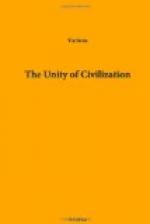The thirteenth century thus witnessed a unity of civilization alike as a structure of life and as a content of the human mind. On the one hand, there rose a single governing scheme of society, which culminated in the universal primacy of Rome and the Roman pontiff. On the other hand, set in this scheme, and contained in this structure, there was a single stuff of thought, directed to the manifestation of the eternal glory of God. The framework we may chiefly ascribe to Gregory VII; the content to St. Thomas Aquinas. But the whole resultant unity is less the product of great personalities than of a common instinct and a common conviction. Men saw the world sub specie unitatis; and its kaleidoscopic variety was insensibly focused into a single scheme under the stress of their vision. The heavens showed forth the glory of God, and the firmament declared His handiwork. Zoology became, like everything else, a willing servant of Christianity; and bestiaria moralizata were written to show how all beasts were made for an ensample, and served for a type, of the one and only truth. All things, indeed, were types and allegories to this way of thinking; and just as every text in the Bible was an allegory to mediaeval interpretation, so all things in the world of creation, animate and inanimate, the jewel with its ‘virtue’ as well as the beast with its ‘moral’, became allegories and parables of heavenly meanings. Thus the world of perception became unreal, that it might be transmuted into the real world of faith; and symbolism like that of Hugh of St. Victor dominated men’s thought, making all things (like the Mass itself, if in a less degree) into signa rei sacrae.




